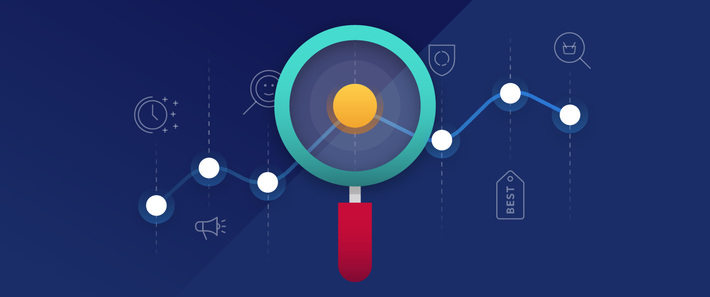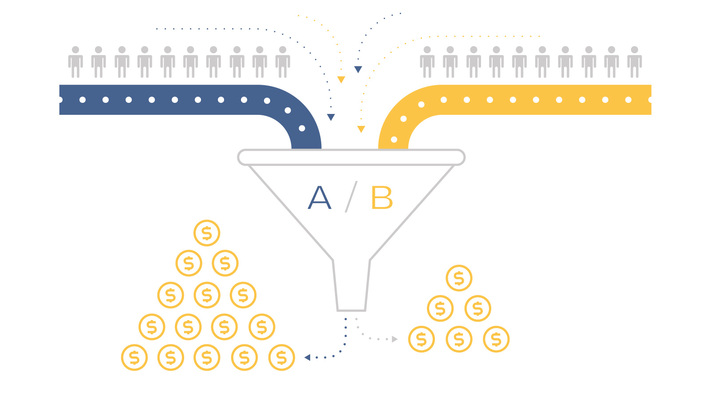
Data science and analytics are growing in their popularity and range of applications in the modern world. Data science deals with answering questions and uncovering hidden insights, while analytics is rather concentrated on the processing itself and conducting of statistical analysis of data sets.
Right at the moment, when we open our browsers the metrics starts being generated. Clicks, likes, shares, impressions, sessions duration, and average time spent within various pages, etc. belong to key digital metrics. Small pieces of data represented by these metrics are of considerable value for the companies eager to increase their customers’ satisfaction rates. Analytics helps to discover insights and use it to improve decision making process and efficiency of business.
Let us concentrate on the use cases, in which the application of data science algorithms and advanced analytics techniques is the most beneficial.
Personalized marketing
Personalized marketing requires in-depth knowledge of a customer on a personal level. The marketers strongly believe that analysis of personal data of prospects and leads plays a decisive role in the success of the overall campaign. Personalization helps to advance and reinforce customers’ relationship and positive attitude towards the brand. Convincing the audience that you treat each customer individually and respect this individuality is crucial.
The brands face the need to track various metrics and apply advanced analytics techniques to personalize their marketing strategies. Thanks to advanced personalization tools and software tracking these metrics coming from multiple sources are now more natural than ever before. Application of such analytics solutions helps brands to get a considerable competitive advantage.
Customer segmentation
Customer segmentation is another essential tool to understand customers better and increase their satisfaction. Collecting customers information and analyzing it is beneficial for the company in many respects.
To bring this analysis to a high level, specialists apply advanced analytics. Great effort should be made to fully understand all the traits and attributes that make customers unique and at the same time, give the ground to segment them according to groups. Customer analytics is a backbone for all types of marketing activities performed by the companies. It helps the companies to break major problems into manageable matters and facilitate decision-making procedures on pricing, promotion, and management. The companies tend to rely on customer analytics more than ever before.
Customer analytics provides visibility into the process of how and why customers choose particular products and how they use these products. Its principal task is to create an accurate view of a customer for its further use with a marketing purpose.

Lifetime value prediction
The tool of customer lifetime value prediction (CLV) has been actively used by the marketers for decades. This tool has already proved its efficiency for business. CLV reflects the value of a customer for the company. Thus, it discloses essential insights, such as profitability, retention, and discounts. The principal goal of the customer lifetime value prediction is to model the purchasing behavior of a customer. CLV is applied in various cases ranging from campaign targeting to customer service optimization. Lifetime value prediction is directly related to the costs of customer acquisition. Thus, the companies can quickly identify which customers are worth the money and time spent and which will not prove to bring revenues.
Optimization of the retention offers also largely depends on the CLV and allows the companies to find a balance between discount rates and their cost for business.
Customer sentiment analysis
Sentiment analysis is also called opinion mining belongs to the field of Natural Language Processing and aims at identifying and distracting of opinions from the context. Currently, sentiment analysis presents a great interest to companies, willing to use every opportunity to provide high-quality customers experience. A great many texts get available for analysis on the internet via blogs, sites, forums, and social media. Thus, there is no difficulty in getting the required data for further analysis.
Applying customer sentiment analysis, the unstructured data is turned into structured information and valuable data insights. The CLV algorithms are capable of distinguishing between facts and opinions, subjective and objective, comparative and direct, explicit and implicit opinions. Application of the advanced analytics allows to differentiate between not only polar (positive, negative, or neutral) opinions but also to detect and recognize emotions (happy, angry, sad, etc.).
Sentiment analysis proved its efficiency in the fields of workforce analytics, product analytics, and market analytics.
Real-time analytics
Real-time analytics is an excellent solution for enterprises to solve the matters of significant complexity of tada processing as soon as it gets to the source. In this case, the level of the computer responsiveness reaches almost instantaneous speed.
Real-time analytics is impossible without the following major software components:
- aggregator, which has to gather data from the real-time event streams;
- broker, which has to make the previously collected data available for consumption;
- analytics engine, which has to analyze data and blend the streams.
Key benefits of real-time analytics application are that errors and complications in operation may be detected instantly; thus, they may be solved immediately; the advantage in competition may be easily achieved, as you can react to the changes in the competitors’ strategies in real-time. Besides, real-time analytics helps to gain insights into your sales. Thus, you get an opportunity to learn which product is doing well on the market.
Therefore, real-time analytics of big data will help not only to monitor the metrics of your website but also to monitor the competitors’ policies and strategies.
Predictive analytics
Predictive analytics as a branch of advanced analytics aims at making assumptions about future events and future development of a particular process. Data mining, statistics, modeling, and machine learning are among numerous techniques of predictive analytics. With the help of these techniques, and careful analysis of the historical data, we may build the models of future events.
The application of predictive analytics makes organizations forward-looking and more confident in their decisions. Thus, the capability of data scientists to provide this confidence to the companies is their main attraction.

Market basket analysis
Market basket analysis is a vivid representation of the analytical technique implementation for a better understanding of the customers’ behavior. This technique allows us to determine which services or products are more often bought together or placed on the same wish list or basket. Thus, market basket analysis aims at deriving associations or patterns.
There are two main types of market basket analysis:
- predictive (classification of cliques, purchases, events, and services made in one sequence);
- differential (filtering of irrelevant results or getting the insights and making an in-depth comparison of the data).
The e-commerce websites primarily rely on the results of market basket analysis in making products suggestions. Therefore, market basket analysis is mainly applied to increase sales and customers’ satisfaction rates.
Warranty analytics
Usually, warranty claims made by the customers cost the manufacturers and retailers a great deal of money. Furthermore, they may result in the decrease of customer satisfaction, brand loyalty and overall trust to a brand. Therefore, the manufacturers are searching the way to reduce the costs of warranty and this is where warranty analytics takes the stage.
Warranty analytics solutions help to automatically integrate vast amount of warranty-related data across the channels. Applying advanced analytics these solutions manage to disclose the warranty-covered defects. However, this process is quite complex and challenging for the companies. The key benefits of this technique are as follows:
- early identification of the problem
- deep understanding of the problem;
- effective management and processing of claims;
- faster settlement of the warranty claims.
Price optimization
Pricing decisions are among the most important for a company. The consumers’ demand, purchasing behavior, satisfaction rate, and the company’s revenues depend on these decisions. The complexity of the prices, which include various variables and a complicated process of demand and profit forecasting make price optimization a challenging task.
A wide range of price optimization tasks may be solved with the help of analytics. For instance, Markdown optimization technique is applied to get insights from the historical data on customers’ buying behavior and trends to suggest optimal discounts rates. In their turn, these optimal discounts will not only increase profit but increase demand at a particular time.
Moreover, data analytics, in this case, may also be used to identify other processes and operations for further optimization. Besides, price optimization analytics plays a vital role in the development of optimal promotional campaigns as well as in search of new opportunities for promotion.
Conclusion
Analytics provides companies with valuable insights, which might be missed out. Data is crucial in modern, data-driven world on your way to success. Analytics is a tool which helps to make this data beneficial, to get a better understanding of the processes and to improve business performance.
In this article, we attempted to put together the most efficient and the most widely applied data science use cases.
